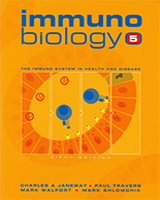By agreement with the publisher, this book is accessible by the search feature, but cannot be browsed.
NCBI Bookshelf. A service of the National Library of Medicine, National Institutes of Health.
Janeway CA Jr, Travers P, Walport M, et al. Immunobiology: The Immune System in Health and Disease. 5th edition. New York: Garland Science; 2001.

Immunobiology: The Immune System in Health and Disease. 5th edition.
Show detailsOnce they have completed their development in the thymus, T cells enter the bloodstream and are carried by the circulation. On reaching a peripheral lymphoid organ they leave the blood again to migrate through the lymphoid tissue, returning to the bloodstream to recirculate between blood and peripheral lymphoid tissue until they encounter their specific antigen. Mature recirculating T cells that have not yet encountered their antigens are known as naive T cells. To participate in an adaptive immune response, a naive T cell must first encounter antigen, and then be induced to proliferate and differentiate into cells capable of contributing to the removal of the antigen. We will term such cells armed effector T cells because they act very rapidly when they encounter their specific antigen on other cells. The cells on which armed effector T cells act will be referred to as their target cells.
In this chapter, we will see how naive T cells are activated to produce armed effector T cells the first time they encounter their specific antigen in the form of a peptide:MHC complex on the surface of an activated antigen-presenting cell (APC). The most important antigen-presenting cells are the highly specialized dendritic cells, whose only known function is to ingest and present antigen. Tissue dendritic cells ingest antigen at sites of infection and are activated as part of the innate immune response. This induces their migration to local lymphoid tissue and their maturation into cells that are highly effective at presenting antigen to recirculating T cells. These mature dendritic cells are distinguished by surface molecules, known as co-stimulatory molecules, that synergize with antigen in the activation of naive T cells. Macrophages, which we described in Chapter 2 as phagocytic cells that provide a first line of defense against infection, can also be activated to express co-stimulatory and MHC class II molecules. This enables them to act as antigen-presenting cells, although they are less powerful than dendritic cells at activating naive T cells. B cells can also serve as antigen-presenting cells in some circumstances. Once a T-cell response has been initiated, macrophages and B cells that have taken up specific antigen also become targets for armed effector T cells. Dendritic cells, macrophages, and B cells are often known as professional antigen-presenting cells.
Effector T cells, as we learned in Chapter 5, fall into three functional classes that detect peptide antigens derived from different types of pathogen. Peptides from intracellular pathogens that multiply in the cytoplasm are carried to the cell surface by MHC class I molecules and presented to CD8 T cells. These differentiate into cytotoxic T cells that kill infected target cells. Peptide antigens from pathogens multiplying in intracellular vesicles, and those derived from ingested extracellular bacteria and toxins, are carried to the cell surface by MHC class II molecules and presented to CD4 T cells. These can differentiate into two types of effector T cell, called TH1 and TH2. Pathogens that accumulate in large numbers inside macrophage and dendritic cell vesicles tend to stimulate the differentiation of TH1 cells, whereas extracellular antigens tend to stimulate the production of TH2 cells. TH1 cells activate the microbicidal properties of macrophages, and induce B cells to make IgG antibodies that are very effective at opsonizing extracellular pathogens for uptake by phagocytic cells. TH2 cells initiate the humoral immune response by activating naive antigen-specific B cells to produce IgM antibodies. These TH2 cells can subsequently stimulate the production of different isotypes, including IgA and IgE, as well as neutralizing and/or weakly opsonizing subtypes of IgG. Fig. 8.1 shows the involvement of the different effector T cells in the immune responses to different classes of pathogens.

Figure 8.1
The role of effector T cells in cell-mediated and humoral immune responses to representative pathogens. Cell-mediated immune responses involve the destruction of infected cells by cytotoxic T cells, or the destruction of intracellular pathogens by macrophages (more...)
The activation of naive T cells in response to antigen, and their subsequent proliferation and differentiation, constitutes a primary immune response. At the same time as providing armed effector T cells, this response generates immunological memory, which gives protection from subsequent challenge by the same pathogen. The generation of memory T cells, long-lived cells that give an accelerated response to antigen, is much less well understood than the generation of effector T cells and will be dealt with in Chapter 10. Memory T cells differ in several ways from naive T cells, but like naive T cells they are quiescent and require activation by antigen-presenting cells with co-stimulatory activity in order to regenerate effector T cells.
Armed effector T cells differ in many ways from their naive precursors, and these changes equip them to respond quickly and efficiently when they encounter specific antigen on target cells. In the last two sections of this chapter we will describe the specialized mechanisms of T cell-mediated cytotoxicity and of macrophage activation by armed effector T cells, the major components of cell-mediated immunity. We will leave the activation of B cells by helper T cells until Chapter 9, where the humoral, or antibody-mediated, immune response is discussed.
Contents
- The production of armed effector T cells
- General properties of armed effector T cells
- T cell-mediated cytotoxicity
- Macrophage activation by armed CD4 TH1 cells
- Summary to Chapter 8
- General references
- Section references
- T Cell-Mediated Immunity - ImmunobiologyT Cell-Mediated Immunity - Immunobiology
Your browsing activity is empty.
Activity recording is turned off.
See more...